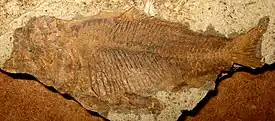Amyzon (fish)
Amyzon is an extinct genus belonging to the sucker family Catostomidae first described in 1872 by E. D. Cope.[1] There are 4 valid species in the genus. Amyzon are found in North American fossil sites dated from the Early Eocene in Washington USA, and several Early Eocene sites in British Columbia Canada including the McAbee Fossil Beds, Driftwood Canyon, and the "Horsefly shale",[2] as well as Early Oligocene sites in Nevada USA.
| Amyzon | |
|---|---|
 | |
| 10cm fossil A. aggregatum | |
| Scientific classification | |
| Kingdom: | Animalia |
| Phylum: | Chordata |
| Class: | Actinopterygii |
| Order: | Cypriniformes |
| Family: | Catostomidae |
| Subfamily: | Ictiobinae |
| Genus: | †Amyzon Cope, 1872 |
| Type species | |
| †Amyzon mentale Cope, 1872 | |
| Species | |
|
See text | |
Species
There are currently four valid species included in Amyzon with up to seven species having been described.[3]
- A. aggregatum (Wilson, 1977) Early Eocene, Horsefly Beds, Horsefly, B.C.; Eocene Green River Formation, Wyoming (synonym A. gosiutensis Grande, Eastman, and Cavender, 1982)
- A. brevipinne (Cope, 1894) Early Eocene, Allenby Formation, Tulameen River, near Princeton, B.C.
- A. commune (Cope, 1874) late Eocene Florissant Formation, Colorado (junior synonyms A. fusiforme Cope, 1875 & A. pandatum Cope, 1874 )
- A. mentale (Cope, 1872) Oligocene, Osino Oil Shales, Nevada
References
- Cope, ED (1872). "On the Tertiary coal and fossils of Osino, Nevada". Proceedings of the American Philosophical Society. 12: 478–481.
- Wilson, MVH (1977). "Middle Eocene freshwater fishes from British Columbia". Life Sciences Contributions, Royal Ontario Museum. Royal Ontario Museum. 113: 1–66.
- Bruner, JC (1991). "Comments on the Genus Amyzon (Family Catostomidae)". Journal of Paleontology. 65 (4): 678–686.
| Wikimedia Commons has media related to Amyzon. |
This article is issued from Wikipedia. The text is licensed under Creative Commons - Attribution - Sharealike. Additional terms may apply for the media files.